A Year in the Life of the OMS Communications Officer and MSt Academic Mentor
As we come to the end of the teaching year and Medieval Matters shuts down for the summer, I was asked to reflect on the year’s happenings, and on some of the work that I do in my role as Communications Officer and my twinned role as the Academic Mentor for the Interdisciplinary MSt in Medieval Studies. As such, I’ve compiled a “menologium” of sorts, highlighting the goings on that have happened across the year. This has been my third year in post since I joined the team in 2021, and it’s been such a delight to see Oxford’s medieval community go from strength to strength during that time. In some ways, then, this report is less about my own work, and more about the strength of the community: which I have been honoured and privileged to witness first hand as your medieval herald and mentor!
JULY
July is the month of beginnings! This might seem odd: Trinity Term is traditionally an end-point for the academic year! But July is the point at which we at OMS are planning forward for the year ahead, and so marks the beginning of the OMS calendar. This is the time of year when we begin planning the Medieval Mystery Plays, thinking about which speakers we will invite and which events we want to host in the year ahead. It’s a very exciting time of year! In 2023, we were planning our OMS lectures and also asking for submissions for the Impact Report.
AUGUST
August is a time for harvesting… submissions for the Impact Report, that is! We had such a lot to celebrate, from book launches to new seminars and reading groups. I am always struck by the phenomenal range of our medieval offerings at Oxford, but collecting all of the information together really emphasised the wealth of languages, approaches and disciplines that we have here.
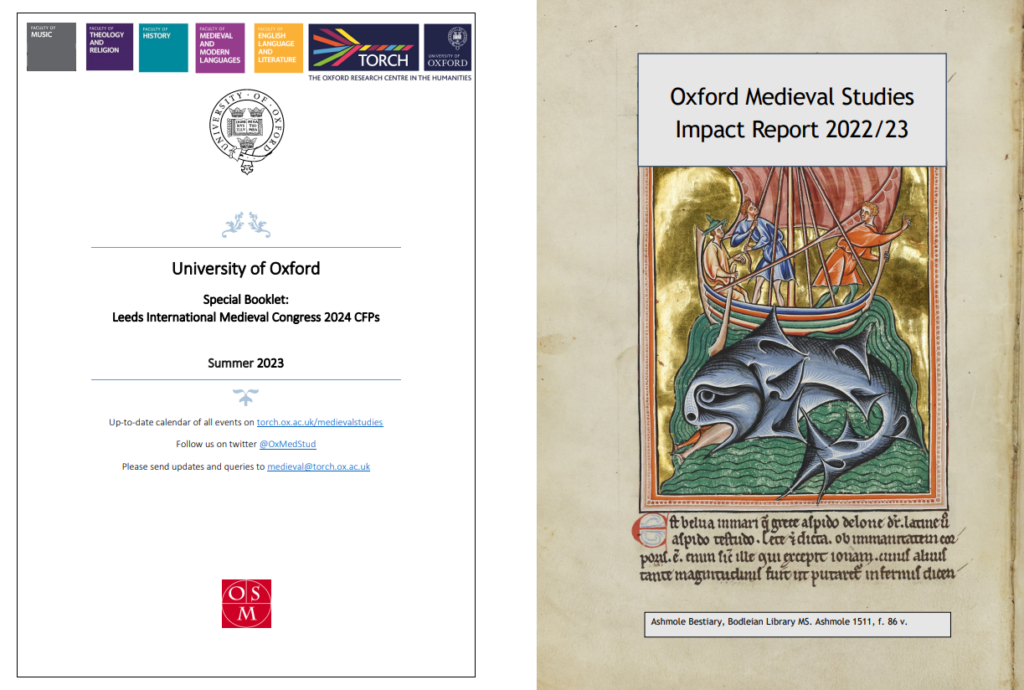
I was also busy ‘harvesting’ CFPs for a special summer CFP booklet. We had 20 pages of CFPs for Leeds IMC, New Chaucer Society, and Kalamazoo panels hosted by Oxford Medievalists: such an astounding range of submissions that they barely fit in a pdf! We had everything from Alfredian Voices to Medievalisms in Times of Crisis: Reception, Adaptation, and Remediation; from “Authentic” Translation?’ to Medieval Onomastics: Crisis or Stasis?
SEPTEMBER
September is the month of preparation! This is the month when I am busy assembling the Medieval Booklet for the term ahead. Of extreme importance, of course, is selecting which manuscript will illuminate the weekly newsletter. This year I opted to highlight one of the offerings at St John’s College, where I am currently appointed. The newly digitised MS 61 bestiary is both delightful to look at and a real testament to the ongoing work of our library and collections staff in making medieval resources more easily available. Special thanks to Sophie Bacchus-Waterman for giving as a sneak peek behind the curtain of archival work in her blog post for us! When choosing images for the emails, I am looking both for entertaining pictures and for those that might be particularly suited to points in the year, and collecting a folder of them for later use. Some of the images are chosen far in advance (like this week 1 image of a Medievalist with their copy of the booklet), whilst others take my fancy on a weekly basis.

Regular recipients of Medieval Matters will know that another important collection is the wisdom quotations. This year I decided to highlight the work of the Epistolae project, based at Columbia University, which catalogues letters to and from medieval women. Featuring quotations from these letters was intended not only to link Oxford’s medievalists to an exciting resource outside of Oxford, but also to provide an inspirational and aspirational model for interdisciplinary, boundary-pushing, open-access and digital humanities work.
September is also the time when we look ahead to our incoming MSt cohort, so we were putting together welcome events and looking ahead to the start of term! An important September task is updating our mailing list: making sure that incoming students and academics are included, and that those leaving us for pastures new have passed on their new details.
OCTOBER
October is the month of welcomes. For the MSt this year this took the shape of the traditional introductory tea, co-run with Prof. Elena Lombardi, the convener of the MSt. It’s so exciting to get to meet all of Oxford’s newest Medieval researchers, and I am always struck by the fantastic range of interests and the sheer passion for the medieval that our MSt students have. On the OMS side, we had a Medievalists’ welcome party co-run with the Medieval Church and Culture graduate seminar: it was lovely to see lots of you there, both old colleagues and new ones! This is also a time of year when my email inbox is particularly busy, as I am fielding questions from both the OMS and MSt side of things in order to make sure that everyone can find their way around the Oxford system. I’m so honoured to be many peoples’ first port of call for discovering the amazing range of medieval happenings at Oxford, and to be able to welcome everyone in our Week 1 Medieval Matters email!
A big part of my October job is making and distributing the term’s medieval booklet, and preparing the newsletter templates This is a big job, and I’ve been extremely grateful for the support of our Graduate Assistant, Eugenia Vorobeva, who has taken on the huge and important task of adding all of the upcoming events to our Google Calendar, to keep everyone informed and up to date.
NOVEMBER
November is a month of social activity. A big part of what we do at OMS is sharing Oxford’s research and community with the wider world. In this I’ve been ably assisted by Ashley Castelino, our Social Media Officer, who has done stellar work on our socials. Some stats for you: our social media following is steadily growing as always, with (at last count) 6396 followers on Twitter/X, 1531 on Facebook, 858 on Instagram, 577 on Mastodon, 202 on Threads, 320 on TikTok, and 80 on our new LinkedIn page. Our most popular video on TikTok so far has been a primer on medieval heralds by Emma-Catherine Wilson with over 2800 views. We also had some very pleasing numbers on the youtube channel. In particular the two live presentations of books / manuscripts from the study day on Homer and the Nibelungenlied have each drawn over 1,500 views by now! The subscriber base also has grown considerably to 427 subscribers. with 17.383 viewings between them.

There is so much going on at Oxford socially that it’s hard to keep up: any medievalist is spoilt for choice! Having reviewed the booklets from the last year, I count regular events working on at least nine languages:
- English
- German
- French
- Latin
- Anglo-Norman
- Norse
- Celtic
- Old Occitan
- Medieval Hebrew
And a huge range of approaches, including:
- Queer and Trans Medievalisms
- Visual Culture
- Environmental History
- Digital Editions
- Music
- Women’s Writing
The fact that I am guaranteed to have overlooked at least two or three regular languages and could only provide a selection of our range of approaches is testament to the richness of our medieval community. But with so much going on, it’s very hard to keep track!
This is where my job as herald comes in. I usually prepare the outlines for each week’s newsletter at the beginning of term, but there are last minute additions, changes, or cancellations every week. So my Monday morning task every week is to sort through my emails to find anything that needs to be added or altered in the draft blog. I am often alerted for example, to new opportunities, or events that have been newly organised; to seminars changing their paper titles or rooms; or just to a good old fashioned cancellation! When I have made all of the changes, the post then passes to my colleague Henrike Lähnemann for review before finally making its way to your inbox. Any medievalist knows that no text would be complete without a set of errata, addenda or corrigenda, so of course I monitor my emails throughout Monday afternoon in order to send out any last minute changes in as few additional emails as possible. It’s busy work, but after three years in post it has become more streamlined, and it’s lovely to come into my office on Monday mornings and know exactly what I’m working on first!
DECEMBER
December is the month of holidays: a time of celebrating and community. Though the days were dark and cold, luckily we had lots to keep our spirits high! In particular we benefited from the medievalists coffee mornings and from the fantastic opening of the Chaucer: Here and Now exhibition!
This is also a time when many of our MSt students are looking at PhD / DPhil programmes. One of my main roles in December as an Academic Mentor is to support students in preparing doctoral applications. I was delighted to host a number of our students for tea at my college to discuss their progress and their career plans – the future of our field looks very bright indeed!
JANUARY
January is the month of new things. In 2023-24, we saw the establishment of several new and exciting additions to OMS. In particular we welcomed the new Dante Reading group, which successfully secured OMS small-grants funding, and convened by one of our very own MSt students, Charlie West. We were also exciting to welcome a new research group, The Oxford Medieval Manuscripts Group (OMMG), a collective of eight of our postgraduate students and early-career researchers who bonded in Oxford over their passion for medieval manuscripts. We also welcomed a new TORCH funded network, Poetry in the Medieval World, lead by Ugo Mondini, Jennifer Guest, Dirk Meyer, Jim Mallinson and Ida Toth. All of these new groups show that even though we often work with dead languages or the distant past, the study of the middle ages is very much alive at Oxford, with new voices and approaches joining the conversation every year!
January is also, of course, the month of our Hilary Term Medieval Booklet, so I am busy assembling that – making sure that everyone’s submissions are received and that they are formatted with our standard font size, layout etc. and are passed on to Eugenia and Ashley to disseminate across our socials and our Google calendar.
FEBRUARY
February is the month of busy research, when the new academic year is in full swing. At OMS, I was excited to be able to highlight a number of our exciting research outputs this year through a series of blog posts, featured prominently in the weekly newsletter. We had submissions on creative-critical approaches to Beowulf; medieval piggy-banks; and a medieval governance workshop – to name just three! I have so enjoyed reading all of our blog post submissions, and sharing them with a wider network at Oxford and beyond. We have also had a number of exciting new monograph publications, including How to Read Middle English Poetry, by Daniel Sawyer; The Old Testament in Medieval Icelandic Texts: Translation, Exegesis and Storytelling, by Siân Grønlie; and Emperor John II Komnenos: Rebuilding New Rome 1118-1143 by Maximilian Lau, amongst many others!
MARCH
March is the month of the OMS Hilary Term lecture! This year we were thrilled to host the distinguished historian of medicine, Peregrine Horden for a talk on ‘Healthy Crusading in the Age of Frederick II: The Puzzle of Adam of Cremona’. We were very fortunate to host this in the Chapel of Harris Manchester – a perfect medievalism space! Thank you so much to everyone who came along, and to Peregrine for such a fantastic talk.
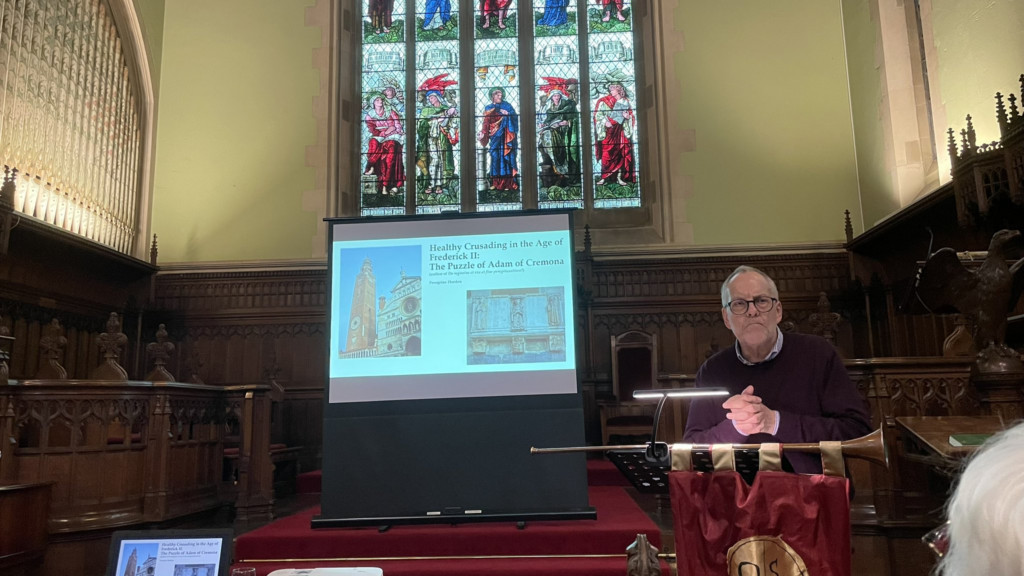
This is also the month when we at OMS try to have a steering group meeting to work out plans for the future: in particular on connections outside of Oxford, and thinking about new events we can run. We were also making plans for our Trinity Term provision.
APRIL
April (with his shoures soote) is the month of new life and of piercing ‘the droghte of March … to the roote’, so a perfect time to celebrate our newest medievalists!
In April all of our MSt students are hard at work producing their dissertations, and every year those on the Medieval Studies MSt present their work at the Medieval Church and Culture Seminar. This year we had a fantastic range of papers, from ‘The Old English and Old Norse ‘Joshua’: translation and readership in context’ to ‘Envisioning Division: marginal medallions in medieval Judaic and Islamic manuscripts’ to ‘Cruising Hell: seeing and writing Dante’s sodomites’. I am always so inspired by the range of approaches and the interdisciplinarity coming out of this MSt programme.
April also marks the Oxford Medieval Graduate Conference, which this year took the theme of Signs and Scripts. For a write-up of the conference and its goings-on, and to be inspired by the newest generation of medievalists, do read Ashley Castelino’s review blog post.

This year we also saw the much-awaited return of the Cambridge, Oxford, and London Symposium on Old Norse, Old English, and Latin (COLSONOEL), sponsored by Oxford Medieval Studies and TORCH. In 2024 a new committee at the University of Oxford, headed by Natasha Bradley, and comprising of Ashley Castelino, Simon Heller, and Mary Catherine O’Connor, took up the reins to bring this symposium back to life.
April is the month of the Trinity Term Medieval Booklet, so at this time of year I am once again collecting submissions, formatting them, and getting ready to share them with our community across all channels!
MAY
May is the month of plotting, and the OMS team were hard at work making plans for the triumphant return of the Medieval Mystery Cycle!

This year we were also busy plotting ways to improve our blog and newsletter, resulting in the move of our WordPress server on May 16th to enable us to host plenty more medieval blog posts and images. Behind the scenes OMS was struggling with server space, meaning a rationing of images and reduction in the number of blog posts we could host. Luckily we have been saved by St Edmund Hall, who have so kindly agreed to host this blog and allow it to continue in all of its manuscript-illuminated glory. Floreat Aula!
JUNE
June heralds the end of a busy medievalist year! As seminars and reading groups start to wind down for the summer, the Medieval Matters Newsletter starts to look shorter and shorter. Our MSt students are all busy finalising their dissertations, so I rarely get to see them, but it’s always a delight to hear how they are getting on. As the end of the academic year, June is a time for goodbyes, as visiting academics and graduate students depart. Thus, my final work of the year is to remind everyone to stay in touch: once an Oxford Medievalist, always an Oxford Medievalist!
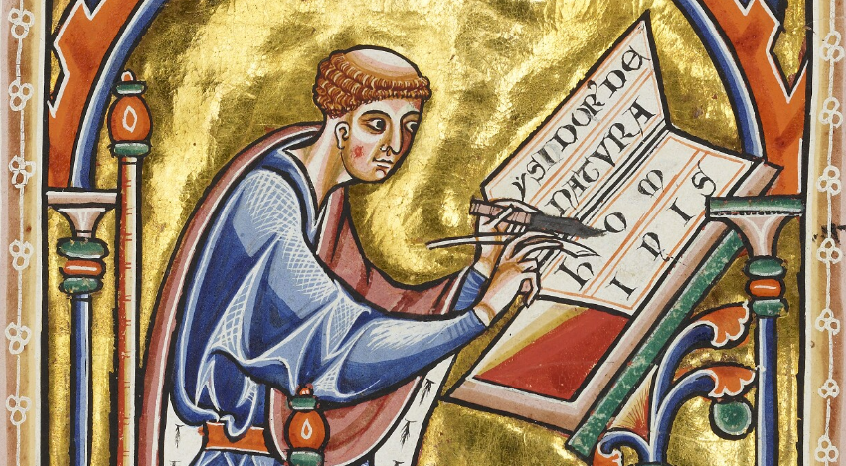









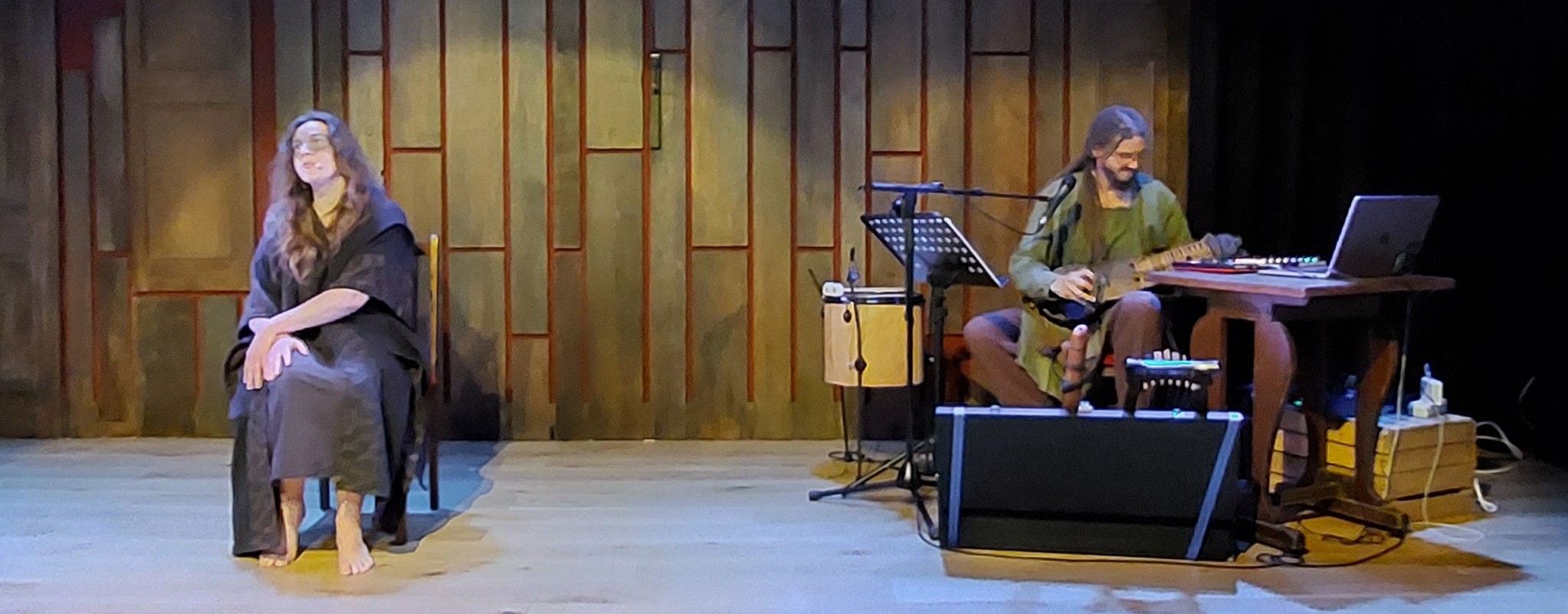



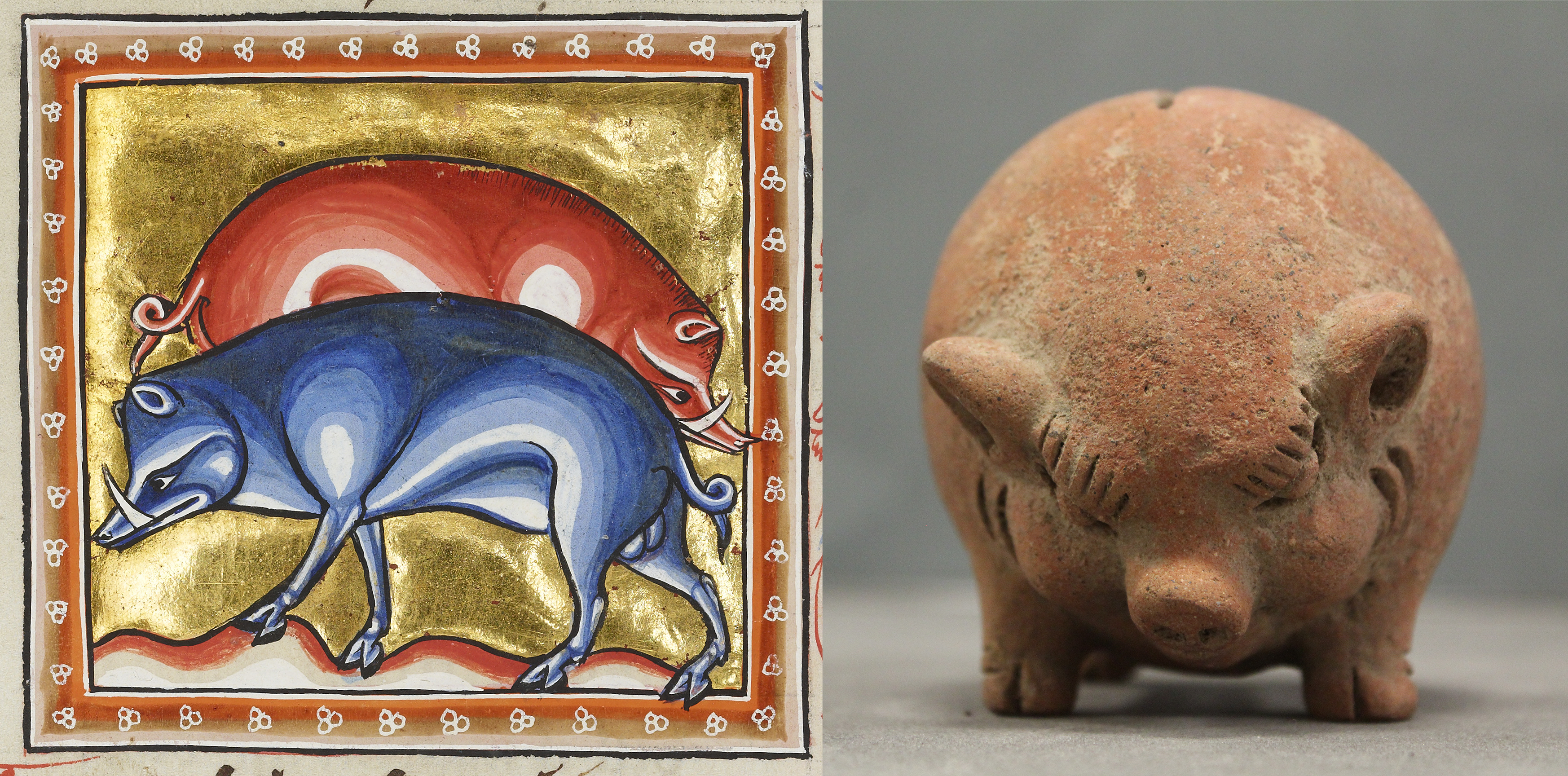


![Stuttgart Manuscript, Psalm 79[80]:13, illumination of a boar uprooting a grape vine.](http://medieval.seh.ox.ac.uk/wp-content/uploads/2023/10/00000198-copy-1024x571.jpg)






























